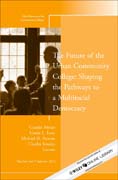
The Future of the Urban Community College: Shaping the Pathways to a Mutiracial Democracy
Myran, Gunder
Ivery, Curtis L.
Parsons, Michael H.
Kinsley, Charles
Urban community colleges––and the cities they serve––are undergoing rapid, multidimensional changes in response to new conditions and demands. The challenge for all community colleges, regardless of size or location, is to reinvent themselves so they can better meet the particular needs of their respective communities. This national higher–education mandate is vital to democracy itself, especially given the multiracial nature of metropolitan areas, where challenges and opportunities have always been most pronounced. This volume looks at how urban colleges are vigorously exploring new strategies for sustainability and success. Some of the most prominent practitioners examine every major aspect of the change–engagement process, including the role of governing boards, workforce development, community partnerships, and redesign of outdated business and finance models. This is the 162nd volume of this Jossey–Bass higher education quarterly report series, an essential guide for presidents, vice presidents, deans, and other leaders in today?s open–door institutions, this quarterly provides expert guidance in meeting the challenges of their distinctive and expanding educational mission. INDICE: EDITORS’ NOTES 1 Gunder Myran, Curtis L. Ivery, Michael H. Parsons, Charles Kinsley 1. Overview: The Future of the Urban Community College 7 Gunder Myran, Michael H. Parsons Leaders are called to transform the very nature of the urban community college just as those who came before them responded to the social revolution of the 1950s and 1960s amid the civil rights movement of that era. 2. The Urban Crisis and Pathways to a Multiracial Democracy 19 Curtis L. Ivery Realization of a multiracial democracy is challenged by color–blind politics and postracial supposition, fueled in part by the election of our first black President in 2008, but contradicted by the chronic persistence of racial segregation and social inequality. 3. A New Leadership Paradigm for the 21st Century 27 Calvin Woodland, Michael H. Parsons Leadership in the 21st century will require new insights and models. The authors blend theory and experience into a design for engaging the “new normal” in higher education. 4. The Future–Shaping Function of the Governing Board 37 Rosemary Gillett–Karam The unique relationship between boards and the urban colleges they serve is examined from the perspective of a university professor who also serves as a community college trustee. 5. The Employability Gap and the Community College Role in Workforce Development 45 Gunder Myran, Curtis L. Ivery Community colleges are becoming the primary source of middle–skill talent through their workforce development programs. This chapter explores the ways urban colleges are striving to close employability and wealth gaps by linking workforce and social equity objectives. 6. Reframing Community Partnerships 55 Jerry Sue Thornton This chapter frames innovative and creative ways to develop unique partnerships with local high schools and employers, exemplified by the best collaborative practices of Cuyahoga and other community colleges. 7. Increasing the Relevance of Curricular and Student Services in the Urban Community College 63 Eduardo J. Padrón Like America itself, Miami Dade College’s evolution as an institution of multiracial democracy started out in reality as quite the opposite—mostly segregated in the beginning, but now a national model of student diversity and success. 8. Achieving a Multiracial Democracy on Campus 75 Rufus Glasper The goal of multiracial equity is not just a phrase in mission statements, but a top–down strategic necessity for community colleges founded on and dedicated to the principles of social justice. 9. Capacity Building: Reshaping Urban Community College Resources in Response to Emerging Challenges 85 Wright L. Lassiter, Jr. Metropolitan community colleges face a myriad of convergent challenges. Sometimes to make sense of it all, it helps to think of an onion, from the outer layers of support to inner core of instructional services. 10. The New Community College Business and Finance Model 93 Gunder Myran Community colleges are transitioning from an old business and finance model to a new future–shaping one. They are being redesigned to become leaner, smarter, more efficient, more creative, and more focused in response to long–term financial constraints as well as rapidly changing workplace skill requirements, technological advances, and globalization. INDEX 105
- ISBN: 978-1-118-80698-2
- Editorial: Jossey Bass
- Encuadernacion: Rústica
- Páginas: 120
- Fecha Publicación: 10/10/2013
- Nº Volúmenes: 1
- Idioma: Inglés
